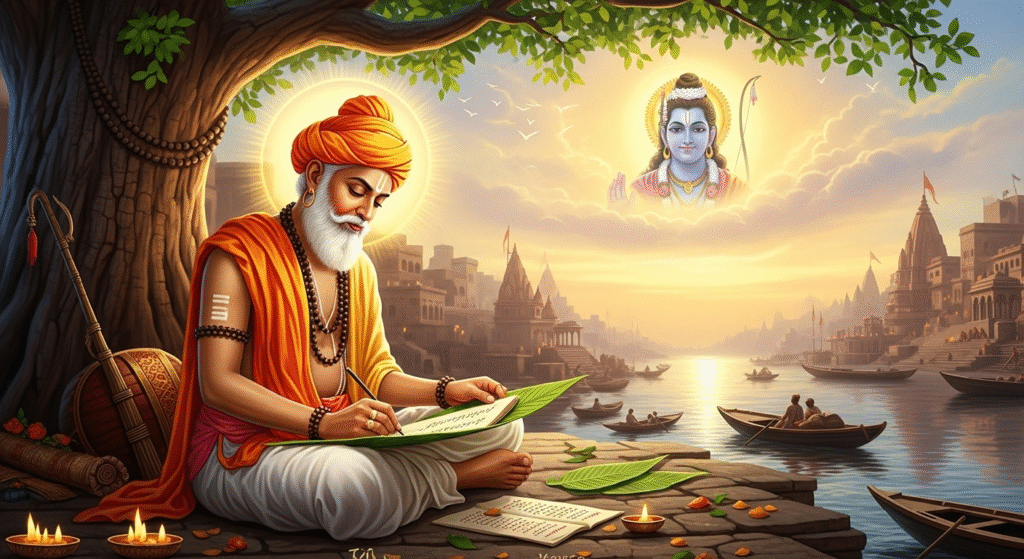
Introduction to Tulsidas: The Literary Saint of India
Tulsidas, also known as Goswami Tulsidas, stands as one of the most celebrated and revered poets and saints in Indian history. His unparalleled contribution to Hindi literature and Indian spirituality has made him a beacon of devotional poetry. Born in the 16th century, he transformed the spiritual landscape of India with his devotional works, most notably the Ramcharitmanas, an epic retelling of the Ramayana in the vernacular Awadhi language.
Early Life of Tulsidas: A Story of Struggle and Spiritual Awakening
Tulsidas was born in Rajapur, a village near Chitrakoot in Uttar Pradesh, around the year 1532 AD. His birth name was Rambola, meaning “one who speaks the name of Rama”. Orphaned at a very young age, he was raised under challenging circumstances. It is said that he was born with 32 teeth fully formed, which gave him an unusual appearance, prompting his mother to abandon him.
He was later adopted by a kind-hearted woman, who raised him in a deeply religious environment. From an early age, he displayed profound devotion to Lord Rama and a remarkable memory, which allowed him to memorize vast religious texts with ease.
Spiritual Journey and Association with Guru Narharidas
Tulsidas was profoundly influenced by his guru, Narharidas, a saint of the Ramanandi sect. Under his guidance, Tulsidas delved deeply into the study of Sanskrit scriptures, Vedas, Puranas, and the Ramayana by Valmiki. However, he recognized the need to bring these sacred texts to the common people in a language they could understand.
This realization led him to compose Ramcharitmanas, a masterpiece that remains a cornerstone of Hindi literature and Hindu devotion.
Ramcharitmanas: A Masterpiece of Devotional Literature
The Power of Accessible Language
Unlike Valmiki’s Sanskrit Ramayana, Ramcharitmanas was written in Awadhi, a dialect of Hindi spoken by the masses. This made the story of Lord Rama accessible to millions who were otherwise excluded due to the language barrier.
Tulsidas’s Ramcharitmanas is not a mere translation but a profound retelling infused with bhakti (devotion), philosophical insights, and poetic beauty. The work consists of seven kandas (books), each narrating a phase of Rama’s life, from his birth to his coronation.
Themes and Impact
The core message of Ramcharitmanas is the triumph of good over evil, the importance of dharma (righteousness), and the power of devotion to God. Tulsidas’s portrayal of Rama as Maryada Purushottam (the ideal man) provided a moral compass for society and remains relevant across centuries.
This epic has been recited, sung, and performed through generations in kathas, bhajans, and Ramlila plays, embedding itself deeply in Indian culture and consciousness.
Other Works of Tulsidas: Gems of Spiritual Literature
While Ramcharitmanas remains his magnum opus, Tulsidas also authored several other devotional and philosophical texts, including:
- Vinay Patrika – A heartfelt collection of hymns and supplications to Lord Rama.
- Hanuman Chalisa – A 40-verse praise of Lord Hanuman, recited daily by millions for protection, strength, and courage.
- Dohavali – A collection of couplets covering ethics, devotion, and the human condition.
- Kavitavali – A poetic elaboration on Lord Rama’s virtues and adventures.
- Gitavali, Barvai Ramayan, and Krishna Gitavali – Lesser-known yet powerful devotional texts.
Each work is imbued with deep philosophical meaning, lyrical richness, and spiritual fervor.
Philosophical Beliefs and Bhakti Movement Influence
Tulsidas was a staunch proponent of the Bhakti movement, which emphasized personal devotion to God over ritualistic practices and priestly mediation. He believed that salvation could be achieved through devotion, love, and surrender to the divine, particularly to Lord Rama.
Unlike many scholars of his time who wrote in Sanskrit, Tulsidas democratized spiritual knowledge by using vernacular language, thus pioneering spiritual egalitarianism.
Tulsidas and the Worship of Lord Hanuman
Tulsidas had immense devotion toward Lord Hanuman, whom he considered a living manifestation of selfless service and unwavering devotion. He is credited with popularizing the Hanuman Chalisa, a powerful hymn that invokes Lord Hanuman’s protection and blessings.
It is believed that through his intense devotion, Tulsidas had a divine vision of both Lord Rama and Lord Hanuman, reinforcing his faith and literary output.
Legacy and Relevance in the Modern World
Cultural Influence
Tulsidas’s works have transcended time, becoming an inseparable part of Indian households and cultural traditions. Ramlila, the dramatic enactment of Ramayana episodes, is largely inspired by Ramcharitmanas and remains a central celebration during Dussehra and Diwali.
Moral and Ethical Teachings
His teachings, grounded in truth, humility, devotion, forgiveness, and self-discipline, continue to guide individuals in personal and social conduct.
Educational Value
In schools and universities across India and abroad, Tulsidas’s writings are studied for their linguistic beauty, spiritual insights, and moral values. His poetic style has inspired countless poets, philosophers, and spiritual leaders.
Tulsidas’s Death and Eternal Presence
Tulsidas passed away in Assi Ghat, Varanasi, around 1623 AD. However, his legacy lives on through his verses, temples, rituals, and millions of hearts that still recite his words daily. The Tulsi Ghat in Varanasi is named after him, a site where he is believed to have spent his final years in meditation and devotion.
Conclusion: The Divine Voice That Lives On
Tulsidas was more than a poet; he was a revolution, a voice of love, humility, and devotion that awakened generations. His decision to write in a language understood by the common people reshaped the religious and literary landscape of India. By elevating devotion and moral integrity through accessible literature, Tulsidas carved a divine niche in Indian culture.
His works continue to illuminate minds, purify hearts, and inspire souls, transcending the boundaries of time, geography, and religion.
